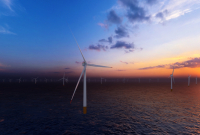Support strong Canadian climate journalism for 2025
Plankton, the key ingredient of the primordial ocean soup that allows all life to flourish, are central to a new U.N. manifesto highlighting the big role microscopic creatures can play in tackling the globe’s triple threat.
Plankton are largely ignored in international discussions around preserving the planet from the climate crisis, biodiversity collapse and pollution, said Vincent Doumeizel, senior advisor on the oceans to the United Nations (U.N.) Global Compact.
“If we want to save our civilization, our species, then I think we should be much more careful about plankton; understand it, and use it as a way to address the biggest challenges of our generation,” Doumeizel said.
Making up 90 per cent of the ocean’s biomass, plankton uses CO2 and emits oxygen during photosynthesis, creating every second breath taken on the planet, he said.
As well as being the foundation of the marine food web, the microscopic organisms also play a critical role in curbing global warming.
While using sunlight to create energy, plankton absorb and sink more than 30 per cent of the carbon pollution produced by humans burning fossil fuels. Each year, an estimated 30 to 50 billion metric tonnes of carbon is fixed in the ocean after plankton are eaten by other animals, or when they die and drop as “marine snow” to the seabed where it is stored for thousands of years.
The Plankton Manifesto, drafted by scientific experts, urges nations, the scientific community and business to collaborate, fund research and focus on how land and ocean use impacts the health of these vital organisms, Doumeizel said.
It also highlights potential solutions plankton offer, like acting as a natural filtration system to clean water before being up-cycled into bio-based plastics and fertilizers, or animal feed.

Typically invisible to the naked eye, plankton populations can explode under certain conditions, allowing these blooms to be seen from space, Doumeizel said.
Plankton monitored by satellites can act as sentinels for change in the ocean due to pollution run-off from land or warming oceans, allowing scientists to monitor the health of marine ecosystems or the impacts of human activity.
Technology, such as satellites, AI, and environmental DNA — genetic materials gathered from ocean and freshwater habitats to identify aquatic life —, are all emerging tools in the understanding of plankton dynamics and potential uses, Doumeizel said.
Brian Hunt, a University of British Columbia professor researching human and climate impacts on the marine food web, agreed plankton are often overlooked in conservation efforts. Human impacts such as pollution and invasive species transported by vessels are altering plankton communities, which could have significant ripple effects for ocean life, food security and the climate on the B.C. coast and beyond, Hunt said.
Important fisheries, shellfish, salmon, and the southern resident killer whales that eat them are all dependent on the health of plankton, he said.
“When we disrupt ocean processes, the first response is from plankton, which then cascades up through the food web,” Hunt said.

Beyond causing global warming, human impacts on plankton are often intensified near urban areas along coastlines —places like the Fraser River in the Lower Mainland of B.C., where cities and farms contribute to “nutrient pollution” of oceans from wastewater, fertilizer or animal waste, he said.
Excess nutrients, such as nitrogen or phosphorus, from such sources — especially paired with warm water temperatures — can spark harmful algal blooms which can be toxic to a lot of marine life and humans eating seafood and cause low oxygen levels in the ocean, Hunt said.
For example, a three-year marine heatwave off the Pacific Coast known as The Blob, decreased the amount of nutritious plankton for marine animals like fish, and caused toxic algal blooms that led to a sharp spike in deaths among humpback whales, other marine mammals and seabirds, either from poisoning or starvation.
More could be done to foster healthy plankton communities by mitigating industrial, agricultural and stormwater runoff from urban areas, he said, adding more research around the effects on plankton communities is needed.
“It's a problem in every urbanized coast environment in the world,” Hunt said.
“Understanding how we can better manage water coming from a city is increasingly important if we're going to have healthy oceans.”
Rochelle Baker / Local Journalism Initiative / Canada's National Observer






Comments